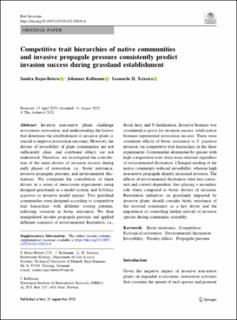| dc.description.abstract | Invasive non-native plants challenge ecosystems restoration, and understanding the factors that determine the establishment of invasive plants is crucial to improve restoration outcomes. However, the drivers of invasibility of plant communities are not sufficiently clear, and combined effects are not understood. Therefore, we investigated the contribution of the main drivers of invasion success during early phases of restoration, i.e., biotic resistance, invasive propagule pressure, and environmental fluctuations. We compared the contribution of these drivers in a series of mesocosms experiments using designed grasslands as a model system, and Solidago gigantea as invasive model species. Two grassland communities were designed according to competitive trait hierarchies with different sowing patterns, reflecting variation in biotic resistance. We then manipulated invader propagule pressure and applied different scenarios of environmental fluctuation, i.e., flood, heat, and N fertilization. Invasive biomass was considered as proxy for invasion success, while native biomass represented restoration success. There were consistent effects of biotic resistance to S. gigantea invasion via competitive trait hierarchies in the three experiments. Communities dominated by species with high-competition traits were more resistant regardless of environmental fluctuation. Clumped seeding of the native community reduced invasibility, whereas high non-native propagule density increased invasion. The effects of environmental fluctuation were less consistent and context-dependent, thus playing a secondary role when compared to biotic drivers of invasion. Restoration initiatives on grasslands impacted by invasive plants should consider biotic resistance of the restored community as a key driver and the importance of controlling further arrivals of invasive species during community assembly. | en_US |

